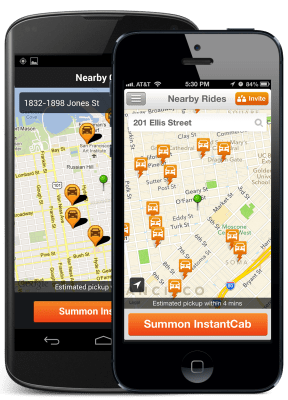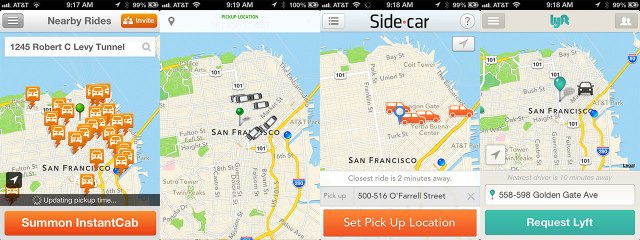There’s no shortage of local taxi and ride-sharing apps out there, with services like Lyft, SideCar, Flywheel, and UBERx all competing for passengers in San Francisco. But a new startup called InstantCab has a unique twist on the transportation app business, by combining inventory of taxi drivers along with community ride-sharing drivers. Together, the company hopes to meet all of the demand that the San Francisco market is throwing at transportation apps, while providing all the same reliability and competitive pricing that local passengers have come to expect.
By having drivers from the ride-sharing community as well as the taxi community, InstantCab seeks to provide more supply, safety, and reliability than the other apps out there. While I haven’t taken an InstantCab yet (for shame!), just by opening up the app you see a lot more available rides than the competition. What you don’t know, at least until you request a ride and have one accepted, is whether or not the car coming your way is being driven by a traditional taxi driver, or by a community ride-share driver. Take a look at this inventory comparison for different transportation apps, all taken within minutes of each other this morning.
Taxi app makers like Flywheel and Taxi Magic might jump in and point out the amount of inventory they have in cities like San Francisco. But here’s the thing — I’ve used most of the taxi apps, and have found that hailing a cab through is an unreliable experience. There have been a number of times when I’ve had my ride accepted by a driver, only to have them drive off in the opposite direction or cancel the ride on me after a few minutes of waiting for them.
The reason tends to be that those cab drivers see a person hailing them down on the street before they make it to the person who requested them via the app. There’s also the unfortunate truth that riders like me have become untrusting toward these e-hail apps for this reason, and will frequently request rides from multiple apps, basically playing them against one another to see which will arrive first. And so it happens that drivers sometimes show up and there’s no one there. The horror!
All of this means distrust on both sides. For drivers, a bird in hand is worth two in the bush, or some such nonsense. They’d rather have the guaranteed fare in front of them instead of the maybe fare they’re driving out to get a mile or so away. And that means that riders sometimes get left out in the cold.
Canceling won’t happen with InstantCab, according to founder Aarjav Trivedi, in part because they work directly with drivers, rather than getting its app installed through the fleet owners. As a result, InstantCab drivers are more likely to actually use the app the way it’s intended. Also, there’s really no way for drivers to cancel. Once they’ve accepted a ride, there’s simply no button they can push to get out of it. The service also has incentives for drivers who consistently pick up riders and provide good service while on the road.
While operating in a beta period, InstantCab already has apps for both iOS and Android. It has done more than 20,000 rides so far, and has several hundred drivers available for rides in San Francisco. When taking a traditional cab booked through the app, the price is the same as what’s on the meter. Community drivers end up having their fares match the same taxi pricing, but fares are based on GPS data from the route that they take.
With that in mind, Trivedi believes InstantCab not only has an inventory and reliability advantage over other services — it also seems to have a price advantage. He’s has done a price comparison of the different services traveling between the same locations, and found InstantCab’s fares are consistently lower than the competition.
Even the ride-sharing services like SideCar and UBERx that have cropped up seem to be somewhat more expensive, based on data he’s collected. For instance, SideCar’s fare was more expensive than InstantCab fares about 75 percent of the time, and UBERx was 33 percent to 50 percent higher than InstantCab fares. Even UBERTaxi fares were higher, by about 5 to 20 percent, and that’s before the mandatory 20 percent tip.
Trivedi has founded and worked at startups that have ranged from security systems used by the Pentagon to transportation automation systems for Universities and public transit systems. The team he’s assembled also includes a veteran taxi driver with more than 30 years of experience, a bunch of engineers and designers who have experience doing transit apps, and a customer services team.
The company isn’t disclosing how much it’s raised, it’s amassed a pretty serious group of investors, including Khosla Ventures, Redpoint Ventures, General Catalyst, Andreessen Horowitz, Owen Van Natta, Harjeet Taggar, Garry Tan, Alexis Ohanian, 5A5 Steakhouse owner Steve Chen, Justin Waldron, Phil Yuen, Joshua Schachter, Reinmkr, and Jared Kopf.
While based in San Francisco and operating there as its initial market, InstantCab hopes to follow other cab and ride-sharing services by expanding into new markets soon. In the meantime, TechCrunch readers in the city can try out InstantCab on their own, and get $5 off their first ride by entering the discount code “InstantCrunch.”

